Angola - Not expensive anymore?

The flight went from Portugal to Angola. Right before boarding the plane in Portugal, all passengers were checked manually again if they all have a valid visa for Angola. Even today after Angola opened its visa policy, it's still not yet well known that it has become a whole level easier for visitors to get a visa.
So first I was wondering how complicated it is to immigrate on an e-Visa, then, of course, I was excited about seeing the scenery of Angola, and last but not least, if the prices of everything (i.e. food) are really as expensive as everybody on the internet is claiming.
What surprised me most before departure was the way to apply for the visa, as I didn't think it would be that easy. With the new e-Visa, it was all done online.
15 years after the end of the civil war Angola's image is about to change a lot. Much is being done to really boost tourism, for example by making it easier to get a visa. At the moment the goal is to attract as many tourists as possible.
15 years after the end of the civil war Angola's image is about to change a lot. Much is being done to really boost tourism, for example by making it easier to get a visa. At the moment the goal is to attract as many tourists as possible.
Difficulty with applying for the Angola e-Visa?
The best thing is definitely that we tourists don't need a letter of invitation anymore and we don't have to turn personal idleness into an embassy.The website to apply for the visa works quite well, but the most difficult part was uploading the photos. Copy of passport and passport photos must have exactly the required resolution, color and file size. Once that was done and everything was submitted, it took 48 hours until I received an email with the pre-authorization document.
This was the document I had to show at the airport. In Luanda, this will be exchanged for an Angola sticker for USD120.
It was necessary to pay USD 120 in cash to exchange the Pre-Authorization letter for a Visa Sticker.
Not even two hours in Angola and artistic paintings and other things can be spotted everywhere, even without searching for them. Angolan art is nice.
But now something more important came in between. I didn't have the visa for Gabon yet and I need it in a few days.
The e-Visa for Gabon did not work, so I had the last chance to get it by going to the embassy here in Luanda.
On the way to the embassy, it was good to already see Luanda by walking through the city toward "Miramar".
The guards are asking for an entrance fee, which seems to change from time to time during the hour and depending on the number of people.
He greeted me with a smile when he saw me wearing long pants (as yesterday he didn't let me enter the premises because I was wearing short trousers).
Some souvenir shops seem to be on the right track here.
My plan for today was to have a day trip with a rental car to Benguela and Baia Farta to see the beautiful beaches and coasts of Angola.
I had my accommodation in 40-minutes-away-Lobito, respectively in the peninsula Restinga. This is the most beautiful area to live or stay in Lobito because it had surprisingly many restaurants and is very clean.
At the end of the road in Restinga, there were about three restaurants right at the beach and one of them was called Zulu.
Since it was almost noon after the search for rental cars, I decided today to see the nearby area around Restinga, comfortably by bicycle.
Luckily, under magical circumstances, I got the opportunity today to have a road trip and see the coast of Benguela. A perfectly relaxed ride all the way from Lobito down to Baia-Farta, by departing early in the morning and having a great day on the road.
It's hard to believe that less than 20 years ago there was a war in Angola. But in the last two decades, the country has recovered.
Driving through Benguela was nice, it's right beside the ocean with only 200 meters from it.
Not too many restaurants are along the way and the ones which are there and open, don't necessarily have menu cards. But all of them have fresh fish.
But here it feels like I only scratched the bare surface of this vast area. There are so many unique and different landscapes all along the coast of which I've seen only a small part.
Not even mentioning how diverse the scenery is when moving inside of the country, to the forests and mountains (Angola has mountains that look very unique).
Luckily I didn't forget to bring a big pizza before arriving at the airport to fill my stomach during lunchtime. The next possibility to eat will probably be sometime around evening in Brazzaville.
Now I'm sitting in the TAAG plane and for 30 minutes the same music is played here without interruption.
Hopefully, the departure will take place soon.
Day 1 - Arriving in Luanda
While boarding the plane in Portugal, the airline employees offered to all passengers to fly in business class for a small additional cost. Because it was a night flight with a duration of 7 hours, it was worth paying that extra and being transported to Angola in a lying position.Exchanging the Pre-authorization letter in a real Visa sticker
This morning at 7am I arrived in Luanda. It was helpful to be one of the first out of the plane because the queue at the immigration desk looked like a long waiting time.However, because I missed the office for the people arriving with E-Visa, I was already in the normal queue. Arriving in front of the queue and the counter, I was kindly told to report to the separate e-Visa office.
It was necessary to pay USD 120 in cash to exchange the Pre-Authorization letter for a Visa Sticker.
The hotel shuttle forgets me...
The hotel taxi has forgotten me, but somehow I expected this. In many African countries the chance that the shuttle will wait reliably outside and on-time, or, waiting at all, is very small. Welcome to Africa?!Not even two hours in Angola and artistic paintings and other things can be spotted everywhere, even without searching for them. Angolan art is nice.
Roaming around in Luanda, but first a visit to the Embassy of Gabon
I had trouble with the Gabon visa, the country I visit after Angola. Of course, my plan was to make the most of the time to see as much of Luanda as possible in the time available. I have planned two whole days in Luanda, so today and tomorrow.But now something more important came in between. I didn't have the visa for Gabon yet and I need it in a few days.
The e-Visa for Gabon did not work, so I had the last chance to get it by going to the embassy here in Luanda.
On the way to the embassy, it was good to already see Luanda by walking through the city toward "Miramar".
Luanda is nicer than I expected!
Being assured of getting the Gabon Visa tomorrow, I happily walked the roads through Luanda.It's very clean and feels all safe to walk here. Along the way several people came towards me when seeing me, wanting to know in a friendly manner:
Luanda is built on some mountainous terrain. The streets are very clean, almost clinically clean for African road conditions on average.
You are a tourist? Really? We didnt have many tourists in the last 15 years. Welcome!
Luanda is built on some mountainous terrain. The streets are very clean, almost clinically clean for African road conditions on average.
Along the streets, there are many possibilities to see the city from above towards the sea.
Monument at the "Largo do Ambiente"
There are no Hop-on-Hop-off buses in Luanda.The streets in Luanda seem much more compact on google maps, but it good to have some slight idea where approximately the point of interest were lying.
Walk towards the "National Bank"
This evening I figured out that I missed some interesting spots when walking through the city, but that I was sometimes only a corner away from them.Before coming here I tried to pin the nicest places of Luanda in google maps, but when google maps even don't have the location to set a pin, it's difficult to find the place at the end.
The walk through the city towards the National Bank.
The walk through the city towards the National Bank.
Yellow House called "Iron Palace"
I had no idea what exactly I'm going to expect before wandering here, but I thought this will be a church or similar.Once it was supposed to become a museum but now it's a place where they have art exhibitions and play live music.
Didn't spend much time around here as it was closed.
Didn't spend much time around here as it was closed.
Around the "National Bank"
Taking photos in Angola is not such a big issue and the police are very relaxed regarding this. The bank is right beside the boulevard at Luanda Bay.
Was ready for a coffee at this point but around here are not many coffee shops.
Along the boulevard
The boulevard is a huge stretch of about almost 3 km.There are not many shops around. It's nice to walk here. I guess on weekends many people go running here.
I guess its a very new monument and asked someone around and they told me:
They also told me that people are a bit angry. Because of the monument, they removed many of the very very old Angolan trees and it upset many people.
Around the X-monument "Soldado Desconhecido"
It's visible from far away when coming from the national bank direction and along the boulevard.
The white piles are supposed to be spears. It's one of the monuments which is visible on google maps but doesn't have a name on it - the "monument of the unknown soldier".
I guess its a very new monument and asked someone around and they told me:
Yes, it's very new. Only built around two years ago, but I don't really know what it is about but I as I heard its build to honor people who have died in wartime without their bodies being identified.
They also told me that people are a bit angry. Because of the monument, they removed many of the very very old Angolan trees and it upset many people.
Outside the National Museum "Fortress São Miguel"
I had to walk up the small hill to get up here to the museum, but there is no entrance fee to be paid.Inside the Museum "Fortress Sao Miguel"
Not many visitors are up here and I was about one of 4 that I counted during the stay of 45 minutes. The area was big and the lookout over the whole bay of Luanda was fantastic.The guards are asking for an entrance fee, which seems to change from time to time during the hour and depending on the number of people.
Don't remember what I paid, it was a small amount like 500 Kwanza but when I left the museum, another visitor arrived. He asked if he can pay his entrance fee of 2000 Kwanza in USD.
View from the Hill "Mausoleum of Agostinho Neto"
The tower over there was the mausoleum of an important person in Angola. Not far from the tower however are the slums of Luanda.It would have been interesting to know the amount of money that was put into this huge monolith.
The view from the hill is spectacular as all is visible, including the port and the many ships which are loading up the oil for export.
Two seconds later the policeman blew a deafening whistle in the direction of the road and ordered one of the motorcyclists to come here.
The view from the hill is spectacular as all is visible, including the port and the many ships which are loading up the oil for export.
Best time to be at the "Fortaleza de Sao Miguel"
The magnificent view is self-explanatory. The best time to be here is around after 3pm.Friendly Police! They help to get a taxi...
Taxis were quite difficult to find or to see, as there are very few official taxis or moto-taxis, or at least not easy to identify as such. In one situation I asked two policemen what the best way to find a taxi was.You want a taxi? Oooooook, I'm the police, let me help you.
Two seconds later the policeman blew a deafening whistle in the direction of the road and ordered one of the motorcyclists to come here.
One moto-taxi driver came along without questioning but bowed his head. A few Portuguese words that sounded like "no time, must continue" were exchanged, but in the claws of the policeman, there was no escape for the driver.
I was then asked where I want to go and then almost forced to take place on the back seat of the motorcycle. The policeman didn't ask for any "Tip" and told the driver how much he can charge me maximum for a ride to my destination in Maculosso.
What hospitality by the police - very nice!
What hospitality by the police - very nice!
Angola is not expensive anymore!
There is a well-known image of Angola to be the most expensive country (or Luanda as a city) in the whole world. I cannot confirm this.Surely it was like that until a few years ago, but since the economy and government changed in the last few years, the exchange rate for Kwanza/Euro fell drastically.
That means since now a few years the prices for tourists are lowered by a huge stake and that results in NOT EXPENSIVE prices for visitors anymore. So my fear was without reason of being ruined when visiting Angola and buying a bottle of water or a pizza.
That means since now a few years the prices for tourists are lowered by a huge stake and that results in NOT EXPENSIVE prices for visitors anymore. So my fear was without reason of being ruined when visiting Angola and buying a bottle of water or a pizza.
Day 2 - One day at "Ilha de Luanda"
After breakfast, I went straight back to the Gabonese Embassy to pick up the passport. This time I wore long trousers to avoid problems with the guard of the embassy.He greeted me with a smile when he saw me wearing long pants (as yesterday he didn't let me enter the premises because I was wearing short trousers).
The ambassador had already done everything and when entering the office she lifted the passport towards me.
The journey took 20 minutes and was longer than I thought.
I wish you a pleasant visit in Gabon and hope you will have many good memories of my country!
Going to the end of Ilha do Cabo, to the "Lighthouse"
Having back my passport now with a Gabon Visa, I happily took a mototaxi all the way to the end of the road, to the Lobito Lighthouse on Ilha do Cabo, the peninsula that stretches around Luanda Bay.The journey took 20 minutes and was longer than I thought.
From far away it looks way smaller but this peninsula stretch is 8km long.
The art-house "Thomson House"
It was a big surprise when walking the street and seeing this.I thought it was just another of these random art houses which want to sell lots of souvenirs, but this one isn't one of them. They didn't even charge for seeing the 4 story building, all covered with masks and paintings from Angola.
The owner explained:
One of the best things to do in Luanda, or as in many cities in Africa, is just to do nothing but walk the streets or watch the scenery and how people work or also do nothing.
The owner explained:
African art has not interested anyone for a long time. But in the past decades, it has changed. Foreigners were not interested in the positive things we produce. And this is complicated, complex, but now slowly we are showing our art.
Just observing the scenery of Luanda
Many restaurants are along the road through the whole peninsula. Many of them have rooftop terraces.One of the best things to do in Luanda, or as in many cities in Africa, is just to do nothing but walk the streets or watch the scenery and how people work or also do nothing.
The 8km beach road through "Ilha do Cabo"
The Ilha, as it is called by the people of Luanda, is connected to the city by a narrow passage and lies at the foot of the São Miguel fortress.This is the place where many people relax from the stress of the capital, especially on weekends.
The nice beach area on this side of the Luanda
On this side of the peninsula is the beach for swimming and the people having their free time. On the other side is the port of Luanda. On this beachside, the water is clean and the air is fresh.On the other side towards Luanda bay, the air was thick and congested and thousands of ship containers were visible.
But both sides were interesting to see in their own context.
But both sides were interesting to see in their own context.
A normal day and its street live along the "Av. Murtala Mohammed"
Many restaurants here as it seems to be the place for a majority of Luandan's and the expats to spend the weekend.Some souvenir shops seem to be on the right track here.
In a few years, they will progressively face many more visitors. I just hope don't become too greedy once the many visitors are going to stream in.
Day 3 - Visiting Catumbela and Lobito
Last night I continued from Luanda to Catumbela, which is an hour flight south.The airport here is very small but nice and quick. Catumbela is also lying almost directly at the beach.My plan for today was to have a day trip with a rental car to Benguela and Baia Farta to see the beautiful beaches and coasts of Angola.
I had my accommodation in 40-minutes-away-Lobito, respectively in the peninsula Restinga. This is the most beautiful area to live or stay in Lobito because it had surprisingly many restaurants and is very clean.
The hotel reception had already tried everything yesterday to organize a rental car, but since there is a huge event or concert in the area during these days, it seemed that there was no such car available.
The streets in peninsula Restinga.
The streets in peninsula Restinga.
Driving around the city of "Lobito"
The hotel staff even took the time to drive me around Lobito, from one car rental company to another car rental company to find a car for me.We drove all over Lobito, but none of the 5 rental car companies had available cars.
Lobito up on the hill "Uptown"
On the hill seem to live the average resident of Lobito.Most of the houses have low standards up here and standards even decrease the further away from the main street it leads.
At specific points along the main road, it's possible to see all the way to Restinga.
At specific points along the main road, it's possible to see all the way to Restinga.
Until the end of Restinga and the "Zulu"
In the afternoon I went back to Restinga. Originally I wanted to drive with a rental car today towards Benguela and Baia Farta. But today there was no rental car available anymore and so I went around Restinga on the bicycle.At the end of the road in Restinga, there were about three restaurants right at the beach and one of them was called Zulu.
With the bike along the peninsula "Restinga"
I gave it up to search for a rental car for today - there are no more available.Since it was almost noon after the search for rental cars, I decided today to see the nearby area around Restinga, comfortably by bicycle.
Day 4 - Day trip to Benguela and Baia-Farta
I'm glad there was no rental car availability yesterday and so based on that, I didn't have the ability to rush myself through the road yesterday for only half-day towards Benguela and back. It would have been very stressful.Luckily, under magical circumstances, I got the opportunity today to have a road trip and see the coast of Benguela. A perfectly relaxed ride all the way from Lobito down to Baia-Farta, by departing early in the morning and having a great day on the road.
It's hard to believe that less than 20 years ago there was a war in Angola. But in the last two decades, the country has recovered.
Angola is definitely another country on the continent with a huge potential for tourism.
Right beside the bridge shown above, there is this little fortress up on the hill which overlooks the Catumbela River, Catumbela itself and the land towards the coast.
In Catumbela, there is the bridge "4 de Abril Bridge"
The former president built it. It was on the way from Catumbela towards Benguela.History right beside the bridge, up on the hill!
On the way down to Benguela were countless beautiful landscapes along the coast and colonial buildings from the time when the Portuguese still had power here.Right beside the bridge shown above, there is this little fortress up on the hill which overlooks the Catumbela River, Catumbela itself and the land towards the coast.
Visiting Benguelas "Coastlines"
Angola has 1650 km of coast with a rocky plateau and landscapes with great nature and culture. The tourist potential is huge but is hardly used so far.This is not surprising, as the almost 30 years of war has eliminated just about everything, from flora to fauna. Animals have been eliminated or escaped and all this is only slowly recovering. It is very important that Angolan investors are also interested in other industries and not only in oil.
Drive through the relaxed city in"Benguela"
The huge white building in the middle of Benguela.The "Bolas Palace" and it is the provincial headquarter of MPLA (the leading political party in Angola). There are lots of security in civil clothes and they didn't really like taking me too many pictures of it.
Driving through Benguela was nice, it's right beside the ocean with only 200 meters from it.
The famous church in Benguela "Se Catedral de Nossa Senhora de Fatima"
A huge church in Benguela comes in a triangular form factor. This exemplar was built only a few years ago in 1963 and properly survived the war.Drive along the street past the Benguelas typical "colonial houses"
Benguela was very picturesque with all its colonial buildings and the clean street.When the Portuguese arrived, the bay of Benguela seemed to be perfect for them as it is right at the ocean and so they started to build this city.
Many 'hidden' beaches along the coast around "Praia da Caota"
South of Benguela there are many beaches and one of them is the Caotinha, which was only possible to access by private 4wd car.In this area is no public bus or taxi.
Between Benguela and Baia-Farta, are "Praia Caota" and "Baia Azul"
Down the coast are Baia Azul and Caota with many beautiful bays of many kilometers in size.A lot of houses have been built in recent years and it will continue like that in the future. The war is over and the country is recovering from it and all the corruption. The time for tourists to come to visit has arrived.
Not too many restaurants are along the way and the ones which are there and open, don't necessarily have menu cards. But all of them have fresh fish.
Before the desert towards Namibe, there was "Baia Farta"
Further down the road was an unpopular and underdeveloped fishing village.But even when underdeveloped and unpopular from a visitor's point of view, it's wonderful to see the authentic people living here and doing their daily living. with the fishing industry.
The Baia Farta coast with all the fishing Boats.
A very small and relaxed town.Probably this area will look completely different in 5 or 10 years, as the influx of tourists and foreign investors will change this place in a business district.
I think in a few years this place will still be a fishing village but under the influence of all the Chinese companies, not necessarily to the favor of the locals here.
Back to Lobito on in the afternoon
The ride back to Lobito was very nice, even the road was almost the same as the way down here. But as the light on the desert and the mountain changes, it looked like a completely different area as in the morning.Angola is nice to visit
It doesn't happen often that I leave a country with a somehow unsatisfied feeling, and now a bigger curiosity even before arriving in a country.But here it feels like I only scratched the bare surface of this vast area. There are so many unique and different landscapes all along the coast of which I've seen only a small part.
Not even mentioning how diverse the scenery is when moving inside of the country, to the forests and mountains (Angola has mountains that look very unique).
Angola is on the shortlist of countries I definitely will go visit again someday.
Tonight I went back from Catumbela to Luanda by plane. Tomorrow at noon I will fly to Brazzaville, the capital of the Republic of Congo.
Day 5 - Departure to the Republic Of Congo
Today at noon was the flight to Brazzaville in the Republic of Congo.The international airport in Luanda is still in the middle of the city in 2020, which makes the journey to the airport very easy and uncomplicated. However, the new airport in Luanda is currently under construction, and that one will be a few dozen kilometers out of town.
New Luanda Airport under construction
The old current airport has clearly become outdated due to the increased amount of people that want to travel. The airport is overcrowded and therefore very confusing and everything is slow. The three hours before departure were quite tedious with waiting.Luckily I didn't forget to bring a big pizza before arriving at the airport to fill my stomach during lunchtime. The next possibility to eat will probably be sometime around evening in Brazzaville.
Outside Angola, there is no Kwanza-Currency exchangeable
Basically, it is not allowed to take the Angolan warming Kwanza out of the country, but since I forgot to change it into Euro, I still had it with me. Probably I won't be able to get rid of these (equivalent) 40 Euro, because no country or person outside of Angola wants to have anything to do with Kwanza's these days. But surely also this will change in the next few years when Angola continues to open its borders.Now I'm sitting in the TAAG plane and for 30 minutes the same music is played here without interruption.
Hopefully, the departure will take place soon.
















































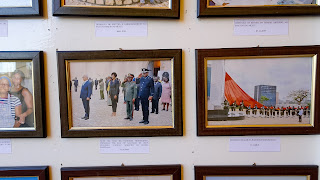




























































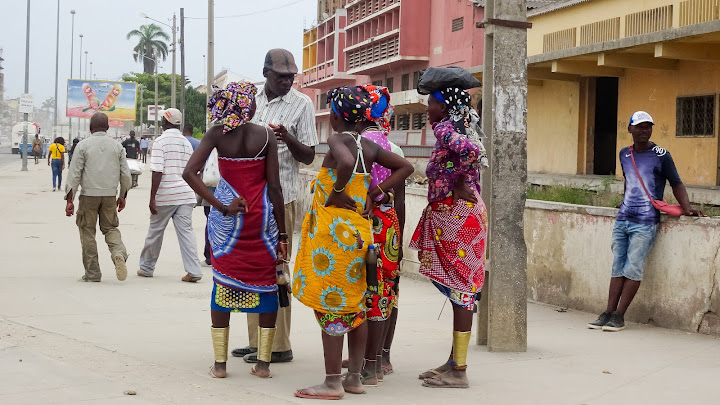







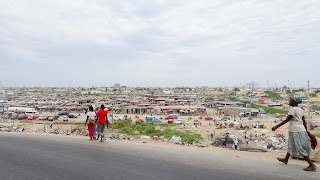

























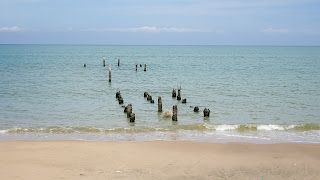




































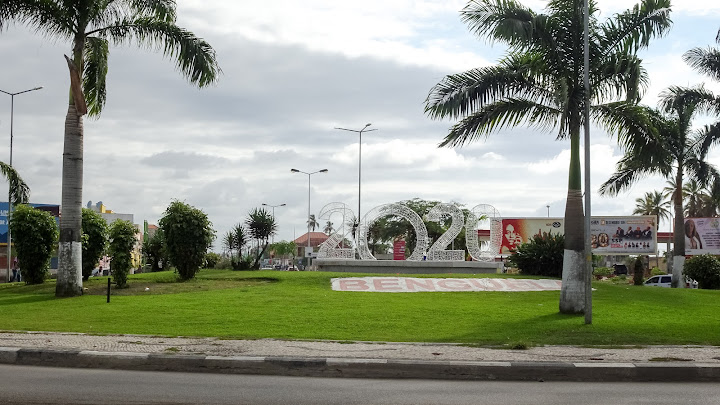




Nice travel blog. Any tips on where to do money exchange, affordable places to buy food, etc. in Angola? Thanks
ReplyDeleteThanks for reading. Money exchange might be tricky, especially for good rates. But it's probably easiest and cheapest when asking around in the streets, not at the banks.
Delete